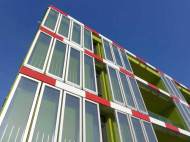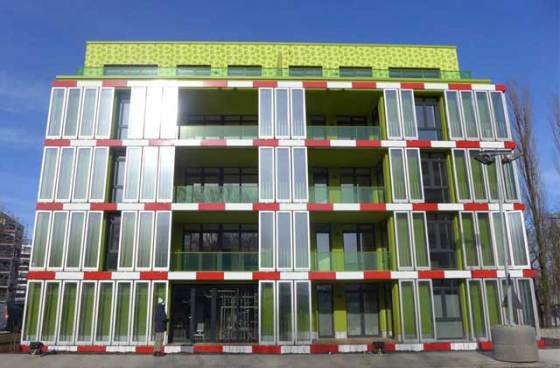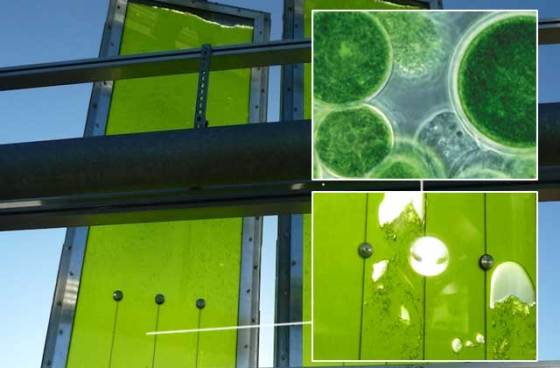BIQ House has bioreactive façade with algae filled panels
 Although the idea of bioreactive façade with algae has been around for a while, the BIQ house is the world’s first building that actually utilizes this technology. The building is a pilot project that showcases this idea as a part of the the International Building Exhibition (IBA) in Hamburg. At the same time, the system also provides dynamic shading, thermal insulation and noise reduction, showcasing various uses of this technology.
Although the idea of bioreactive façade with algae has been around for a while, the BIQ house is the world’s first building that actually utilizes this technology. The building is a pilot project that showcases this idea as a part of the the International Building Exhibition (IBA) in Hamburg. At the same time, the system also provides dynamic shading, thermal insulation and noise reduction, showcasing various uses of this technology.
By the end of 2013, a realization of eleven projects will address the challenges of current sustainability challenges of building and co-existence. Four themes for the model venture are summarized under the Building Exhibition within the Building Exhibition project: Hybrid Houses, Smart Material Houses, Smart Price Houses and WaterHouses.
Designed by SPLITTERWERK, BIQ house is a cubic, five-storey passive-energy building with two differently designed façades – a bioreactor façade with algae on the south-western and eastern side of the building and rendered façade on the north-western and north-eastern side of the building. Spacious loggias with a view will be a high-quality outside living area for each of the 15 apartments and gross floor area of 1,600 square meters (17,222 square feet). The residents will be able to observe the bioreactor facade from close quarters here.
The bioreactive façade system is the result of three years of research and development by Colt International based on a bio-reactor concept developed by SSC Ltd and design work led by the international design consultant and engineering firm, Arup.
The microalgae used in the facades are cultivated in flat panel glass bioreactors where they produce biomass and heat through photosynthesis and solar thermal energy. Aside generating energy, the panels can be used to control the light inflow and shading of the building. As a result of the consistent growth of the algae, the facade will appear dynamic in both pattern and color. The production of regenerative energy will not take place in an invisible energy centre, but will be an explicit component of the architectural concept.
“Using bio-chemical processes in the façade of a building to create shade and energy is a really innovative concept. It might well become a sustainable solution for energy production in urban areas, so it is great to see it being tested in a real-life scenario”, said Jan Wurm, Arup Research Leader.
The heart of the system is the fully automated energy management centre where solar thermal heat and algae are harvested in a closed loop to be stored and used to generate hot water. The heat is directly available to the house as heating energy, while the generated algae biomass becomes utilized in another location and converted into biogas.
The microalgae used in the façades are cultivated in flat panel glass bioreactors measuring 2.5m x 0.7m (8.2 x 2.3 feet). In total, 129 bioreactors have been installed on the south west and south east faces of the four-storey residential building, creating a total surface of 200 square meters (2152 square feet).
Geothermal energy and the connection to the Integrated Energy Network Wilhelmsburg Central secure the heat supply and also serve as a long-term reservoir for the heat that is generated in summer. The extensively greened roof provides the opportunity to harvest electricity via the photovoltaic system.
The apartments will employ the concept used by some dorm rooms and caravans – dwelling on demand has found its contemporary enhanced development in the BIQ. Rooms functions can be alternatively or simultaneously ‘patched in’ to form a neutral zone suitable for different needs.
The functions of the apartment such as bathroom, kitchen, sleeping areas are located in built-in furniture that will be standing within the neutral space. Part of the day and needs of everyday life influence the layout of the apartment. New interior impressions and functional relationships will be created and enabled in interplay with the furniture elements, user behavior and the special finishing of the surfaces.











author
Although the building was finished in March, the system will be officially presented to the media on 25 April 2013 when the biofaçade system goes into operation for the first time. We’ll be updating this article with new images and publishing another article related to the technology employed by the biofaçade panels in the meantime.
A green building that is actually green :)